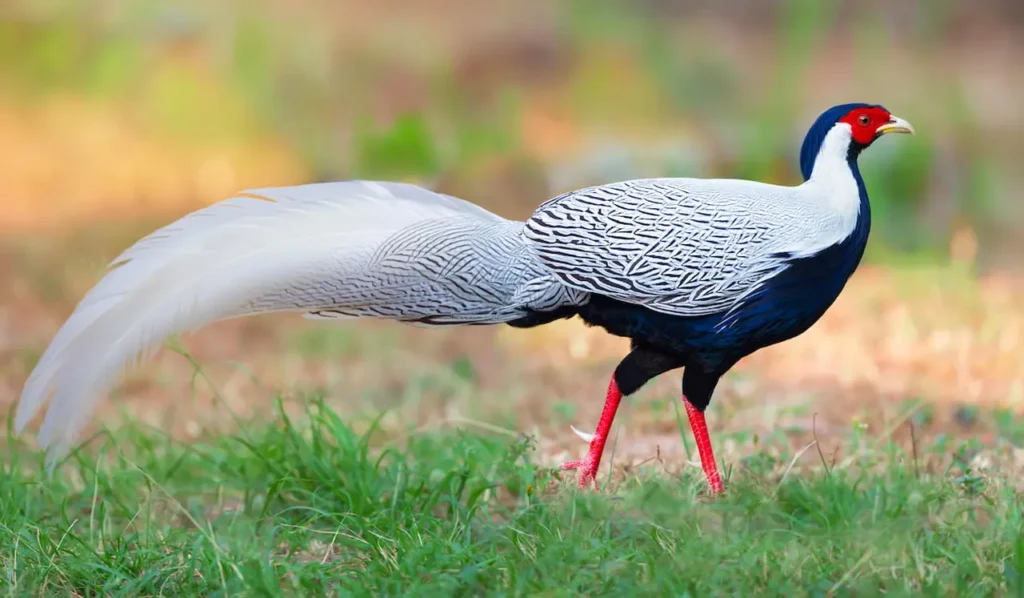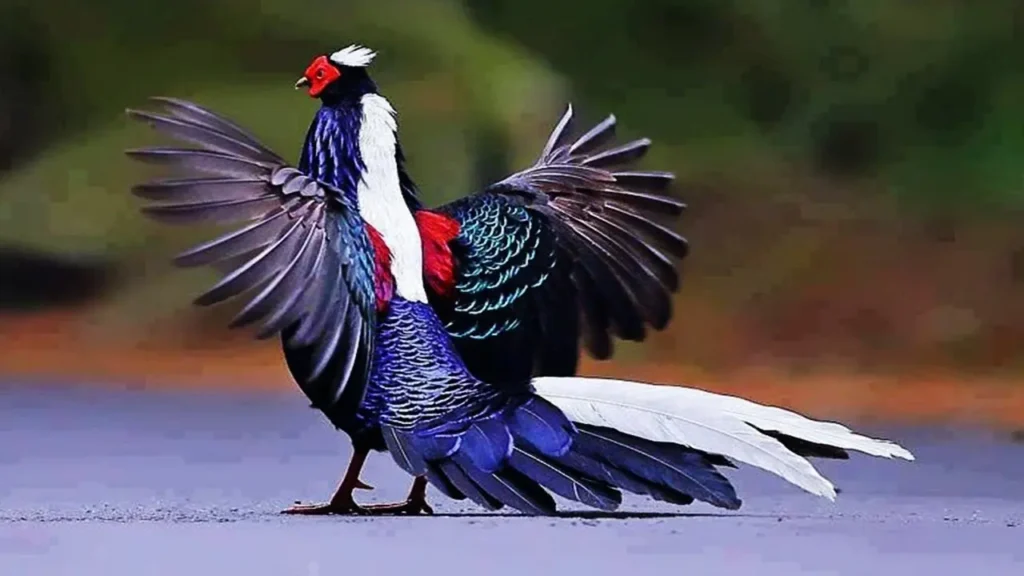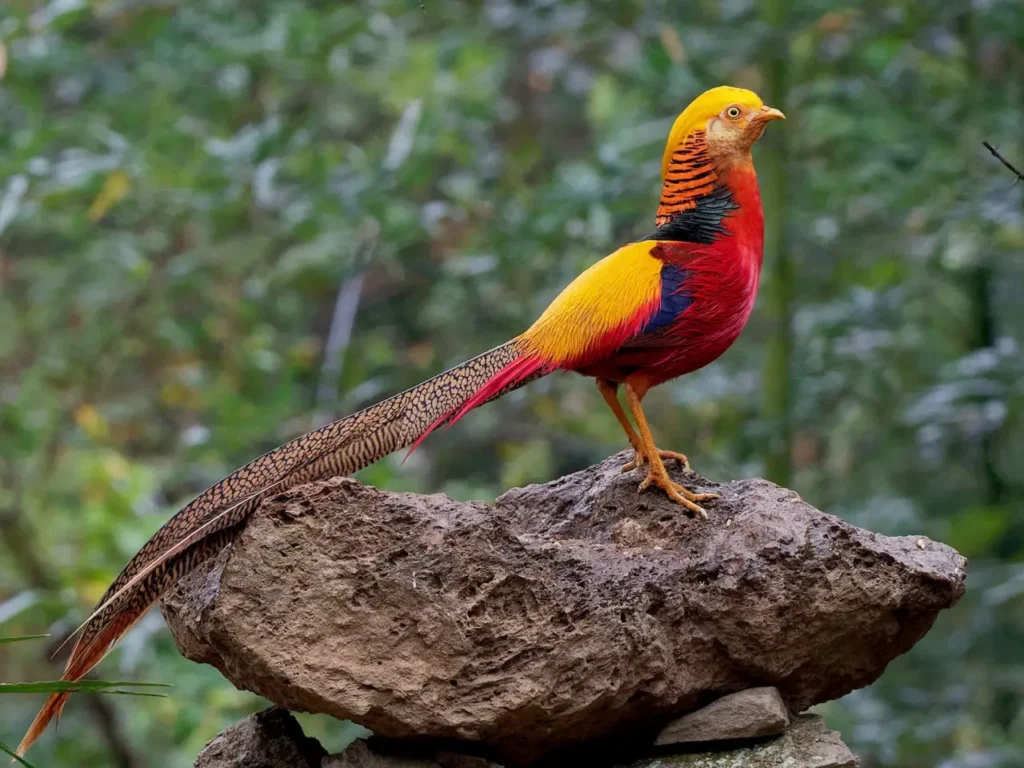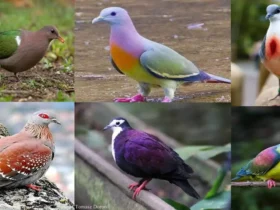Pheasants are a family of birds known for their vibrant plumage and striking appearances. They belong to the family Phasianidae, which includes various species of game birds.

Pheasants are native to Asia and are widely distributed across different regions, including forests, grasslands, and agricultural areas. Here are some key points about pheasants:
- Physical Characteristics: Pheasants vary in size and appearance depending on the species. Generally, they have long, strong legs, a stout body, and a distinctive, elongated tail. The males (known as cocks or roosters) are usually more colorful and larger than the females (known as hens). Their plumage displays a dazzling array of colors, including vibrant greens, blues, reds, golds, and browns.
- Species Diversity: There are numerous species of pheasants, each with its own unique characteristics. Some well-known species include the Common Pheasant (Phasianus colchicus), Golden Pheasant (Chrysolophus pictus), Lady Amherst’s Pheasant (Chrysolophus amherstiae), and Reeves’s Pheasant (Syrmaticus reevesii).
- Habitat and Distribution: Pheasants are native to Asia but have been introduced to other parts of the world for hunting and ornamental purposes. They inhabit a variety of habitats, including forests, grasslands, wetlands, and agricultural landscapes. Different species have adapted to specific ecological niches within their respective ranges.
- Behavior: Pheasants are primarily ground-dwelling birds but can fly relatively well over short distances when necessary. They are known for their elaborate courtship displays, which involve vibrant plumage, vocalizations, and physical movements to attract mates. Pheasants are omnivorous, feeding on a diverse diet that includes seeds, grains, insects, vegetation, and small invertebrates.
- Cultural Significance: Pheasants have cultural significance in many regions, often associated with hunting, traditional ceremonies, or decorative purposes. They are popular game birds and are sought after for their meat and challenging hunting experiences. Their vibrant feathers are also used in various crafts and traditional attire.
- Conservation Status: While some pheasant species are abundant and widely distributed, others are facing conservation challenges. Habitat loss, hunting pressure, and the introduction of non-native species have contributed to declines in certain populations. Efforts are being made to conserve and manage pheasant populations through habitat restoration, protected areas, and sustainable hunting practices.
It’s important to note that specific information about pheasants may vary depending on the species, as each has its own unique characteristics and ecological requirements.

Common types of pheasants today
There are various species and subspecies of pheasants found around the world. Here are some notable types of pheasants:
- Common Pheasant (Phasianus colchicus): Also known as the Ring-necked Pheasant, it is one of the most widespread and well-known pheasant species. It has a colorful plumage, with males sporting long, iridescent feathers and a distinctive white neck ring.
- Golden Pheasant (Chrysolophus pictus): This strikingly beautiful pheasant is native to the mountains of China. The male has a golden crest on its head, red body plumage, and a long, flowing orange and black tail. The female has more subdued colors.
- Lady Amherst’s Pheasant (Chrysolophus amherstiae): This pheasant is named after Lady Sarah Amherst, the wife of the first Baron Amherst of Hackney. It is known for its elaborate and colorful plumage, with a white head, black and silver body feathers, and long, elegant tail feathers.
- Silver Pheasant (Lophura nycthemera): Found in parts of Southeast Asia, the male Silver Pheasant has a black and white plumage, while the female is more camouflaged with brown feathers. They are known for their graceful appearance and long, flowing tail feathers.
- Reeves’s Pheasant (Syrmaticus reevesii): Native to China, this species is named after British naturalist John Reeves. The male has a chestnut body, a long, white-tipped tail, and an intricately patterned head. The female is less colorful but still has an attractive appearance.
- Mikado Pheasant (Syrmaticus mikado): Endemic to Taiwan, the male Mikado Pheasant has a distinctive appearance with a bright orange-red body, a long, white-tipped tail, and a unique, ornate head pattern. The female has more subtle colors.
- Kalij Pheasant (Lophura leucomelanos): This pheasant is found in parts of Asia, including India, Nepal, and Myanmar. The male has a black and bluish-gray plumage with a crest on its head, while the female has brown feathers with a mottled pattern.
- Elliot’s Pheasant (Syrmaticus ellioti): Native to Vietnam and Laos, this species has a striking appearance with a bright red body, a black and white-spotted neck, and a long, sweeping tail. The female is more muted in color.
- Great Argus Pheasant (Argusianus argus): Found in Southeast Asia, particularly in Indonesia and Malaysia, the male Great Argus Pheasant is known for its elaborate and eye-catching plumage. It has a highly ornate pattern of intricate feathers and long, decorative wing feathers. The female has more subdued colors and lacks the elaborate feathers.
- Koklass Pheasant (Pucrasia macrolopha): Native to the Himalayas and surrounding regions, the male Koklass Pheasant has a grayish-brown body with intricate patterns, a prominent crest, and distinctive facial markings. The female has more camouflaged plumage.
- Cheer Pheasant (Catreus wallichii): This pheasant species is native to the western Himalayas. The male Cheer Pheasant has a rusty brown body with grayish-blue wings, a prominent crest, and a long, pointed tail. The female has more muted colors.
- Swinhoe’s Pheasant (Lophura swinhoii): Endemic to Taiwan, Swinhoe’s Pheasant is a critically endangered species. The male has a black and white plumage with an iridescent green and blue neck, while the female has brown feathers with white spots.
- Himalayan Monal (Lophophorus impejanus): Also known as the Impeyan Monal, this pheasant is the national bird of Nepal. The male has a colorful plumage with metallic green, blue, and purple feathers, a prominent crest, and long, shimmering tail feathers. The female is more camouflaged with brown feathers.
- Crested Fireback Pheasant (Lophura ignita): Found in Southeast Asia, particularly in Indonesia and Malaysia, the male Crested Fireback Pheasant has a dark body with a distinctive fiery crest, red facial skin, and intricate markings. The female has more subdued colors.
- Blood Pheasant (Ithaginis cruentus): Native to the high-altitude regions of the eastern Himalayas, the male Blood Pheasant has a chestnut body with a white belly, bright red facial skin, and striking red patches on its wings. The female has similar markings but is less vibrant in color.
- Crested Argus (Rheinardia ocellata): Found in Southeast Asia, particularly in Thailand and Myanmar, the male Crested Argus has a stunning plumage with intricate patterns of feathers, a distinctive crest, and large eye-like spots on its wings. The female has more camouflaged colors.
- Tragopan Pheasant (Tragopan sp.): Tragopan pheasants are a group of colorful and elusive birds found in various parts of Asia. They are known for their vibrant plumage, unique head ornaments, and inflatable throat sacs that males display during courtship. Species within the Tragopan genus include the Satyr Tragopan, Blyth’s Tragopan, and Temminck’s Tragopan, among others.
- Edwards’s Pheasant (Lophura edwardsi): Endemic to Vietnam and Laos, Edwards’s Pheasant is a critically endangered species. The male has a rich, iridescent blue-black plumage with a distinctive white crest and red facial skin. The female is more camouflaged with brown feathers.
- Temminck’s Tragopan (Tragopan temminckii): This pheasant species is native to the eastern Himalayas and parts of Southeast Asia. The male has a vibrant combination of red, orange, and black feathers, with unique blue facial skin and horn-like projections on its head. The female has more subdued colors.
- Copper Pheasant (Syrmaticus soemmerringii): Native to the forests of Japan and parts of China, the male Copper Pheasant has a coppery-red plumage with a distinctive white neck ring and a long, elegant tail. The female has more camouflaged colors.
- White Eared Pheasant (Crossoptilon crossoptilon): Found in the mountainous regions of China, the White Eared Pheasant has a beautiful blue-gray plumage, a white patch behind the ear, and a long, white-tipped tail. The female has more muted colors.
- Hume’s Pheasant (Syrmaticus humiae): Found in the mountainous regions of China and Southeast Asia, the male Hume’s Pheasant has a dark plumage with a white crest, a red facial mask, and an elongated tail. The female has more camouflaged colors.
- White Crested Kalij (Lophura leucomelanos hamiltoni): This subspecies of Kalij Pheasant is known for its distinctive white crest on the top of its head. The male has a blackish-brown body with a blue sheen and a reddish-brown lower back. The female has more camouflaged colors.
- Grey Peacock-Pheasant (Polyplectron bicalcaratum): Native to Southeast Asia, the Grey Peacock-Pheasant is named for its intricate and iridescent plumage, resembling the patterns of a peacock. The male has a bluish-gray body with colorful eye-like spots on its tail feathers. The female has more muted colors.
- Palawan Peacock-Pheasant (Polyplectron napoleonis): Found only in the Palawan Islands of the Philippines, this species is known for its unique and beautiful plumage. The male has a metallic green-blue body with elongated tail feathers adorned with striking eye-like patterns. The female has more subdued colors.
- Salvadori’s Pheasant (Lophura inornata): Endemic to the island of Sulawesi in Indonesia, Salvadori’s Pheasant is known for its glossy black plumage with iridescent green and purple hues. The male has a red facial skin and a small crest, while the female is more camouflaged with brown feathers.
- Sri Lanka Junglefowl (Gallus lafayettii): The national bird of Sri Lanka, this species is a close relative of domestic chickens. The male has a colorful plumage with a red and gold crest, a black body, and elongated neck feathers. The female has more camouflaged colors.
- Crestless Fireback Pheasant (Lophura erythrophthalma): Found in Southeast Asia, particularly in Thailand and Malaysia, the Crestless Fireback Pheasant has a dark body with distinctive red facial skin and intricate patterns on its plumage. The female has more muted colors.
- Siamese Fireback (Lophura diardi): Found in Southeast Asia, particularly in Thailand and Cambodia, the Siamese Fireback is known for its striking plumage. The male has a black body with a white belly, red facial skin, and intricate patterns on its back and wings. The female has more camouflaged colors.
- Silver Pheasant (Lophura nycthemera): Native to East Asia, the male Silver Pheasant has a striking black and white plumage with a metallic sheen, a long white crest, and a red facial mask. The female has more camouflaged colors.
- Crested Tree Partridge (Rollulus rouloul): Found in Southeast Asia, this species is known for its unique appearance. Both males and females have intricate patterns on their plumage, with the male featuring a prominent crest and colorful facial skin.
- Green Junglefowl (Gallus varius): Native to the forests of Southeast Asia, the Green Junglefowl has a colorful plumage with a greenish sheen, a prominent red crest, and elongated neck feathers. The female has more camouflaged colors.
- Bulwer’s Pheasant (Lophura bulweri): Native to the forests of Borneo, this pheasant species has a dark plumage with metallic green and purple feathers, a white crest, and a red facial mask. The female has more muted colors.
- Red-billed Firefinch (Lagonosticta senegala): This small bird is found in sub-Saharan Africa and is known for its vibrant plumage. The male has a red beak, a red face, and reddish-brown feathers with intricate patterns. The female has more subdued colors.
- Lady Amherst’s Pheasant (Chrysolophus amherstiae): Native to southwestern China and Myanmar, Lady Amherst’s Pheasant is known for its stunning plumage. The male has a black body with colorful, iridescent feathers on the neck and tail, while the female has more camouflaged colors.
- Silver-eared Mesia (Leiothrix argentauris): This small bird is native to the Himalayas and Southeast Asia. It has a bright yellow body with a black head, white eye ring, and distinctive silver ear patches.
- Red Junglefowl (Gallus gallus): The ancestor of domestic chickens, the Red Junglefowl is found in Southeast Asia. The male has vibrant red plumage with a prominent comb and wattles, while the female has more muted colors.
- Koklass Pheasant (Pucrasia macrolopha): Native to the Himalayas and parts of Central Asia, the Koklass Pheasant has a distinctive appearance. The male has a grayish-brown body with a white collar and black facial markings, while the female has more camouflaged colors.
- Malayan Peacock-Pheasant (Polyplectron malacense): Found in Malaysia and Thailand, the Malayan Peacock-Pheasant has a distinctive and intricate plumage. The male has a rich, iridescent blue and green body with elongated tail feathers adorned with eye-like patterns. The female has more camouflaged colors.
- Ring-necked Pheasant (Phasianus colchicus): Native to Asia, the Ring-necked Pheasant has been introduced to many parts of the world for hunting. The male has a brown body with an iridescent green head, a white ring around the neck, and a long, pointed tail. The female has more camouflaged colors.
- Bulwer’s Pheasant (Lophura bulweri): Found in Borneo, Bulwer’s Pheasant has a distinct appearance. The male has a black body with metallic green and purple feathers, a white crest, and a red facial mask. The female has more muted colors.
- Reeve’s Pheasant (Syrmaticus reevesii): Native to China, Reeve’s Pheasant is known for its long, elegant tail feathers. The male has a dark body with a white belly, a red facial mask, and intricate patterns on its plumage. The female has more camouflaged colors.
- Malay Crested Fireback (Lophura ignita): Found in Southeast Asia, the Malay Crested Fireback has a striking appearance. The male has a dark body with a bright red crest, blue facial skin, and intricate patterns on its plumage. The female has more camouflaged colors.
- Silver Pheasant (Lophura nycthemera): Native to East Asia, the Silver Pheasant is known for its metallic plumage. The male has a black body with white speckles, a long, white crest, and a red facial mask. The female has more camouflaged colors.
- Mikado Pheasant (Syrmaticus mikado): Endemic to Japan, the Mikado Pheasant is a visually stunning species. The male has a dark body with bright red and green feathers, a long, white crest, and a red facial mask. The female has more camouflaged colors.
- Impeyan Pheasant (Lophophorus impejanus): Native to the Himalayas, the Impeyan Pheasant is known for its vibrant plumage. The male has a metallic green and blue body, a long, flowing crest, and elongated, shimmering tail feathers. The female has more camouflaged colors.
- Green Pheasant (Phasianus versicolor): Found in Japan, the Green Pheasant is known for its vibrant plumage. The male has a greenish-bronze body with intricate patterns, a red facial mask, and a long, pointed tail. The female has more camouflaged colors.
- Blyth’s Tragopan (Tragopan blythii): Native to the Eastern Himalayas, Blyth’s Tragopan is a medium-sized pheasant with striking colors. The male has a dark body with bright orange, red, and white plumage on the head, a blue face, and fleshy blue wattles. The female has more camouflaged colors.
- Red-crowned Crane (Grus japonensis): This large bird, also known as the Japanese Crane, is known for its elegance and beauty. It has a white body with a red crown, black wingtips, and a long, graceful neck. The Red-crowned Crane is an iconic symbol of Japan.
- Copper Pheasant (Syrmaticus soemmerringii): Native to East Asia, the Copper Pheasant is named for its copper-colored plumage. The male has a rich copper body with a white belly, a long, white crest, and a red facial mask. The female has more camouflaged colors.

These are just a few examples of the many types of pheasants that exist. Each species has its own unique characteristics, plumage patterns, and distribution ranges, making them fascinating and beautiful birds to observe.








